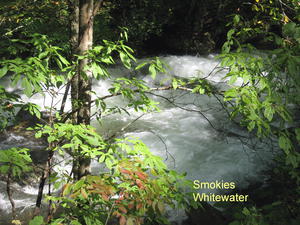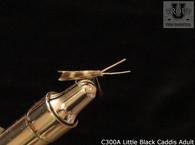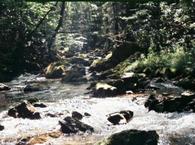
This has been a colder than normal winter for Southeastern streams like the Little River in the Great Smoky Mountains National Park; and the long term forecasts are for the colder than normal weather to continue in the park as well as across the Southeast. In the Smoky Mountains National Park near Gatlinburg, the air temperature is expected to reach a high of only 43 degrees F today, trending higher until reaching into the sixties, and then lower again on Monday. How can we expect the cooler air temperatures and fluctuations to impact the mayfly hatches?
The air temperature ultimately determines the water temperature and we will use the water temperature as a guideline. It's the overall average water temperature from the time the insect is an egg until it emerges into an adult fly that's important. For several years, the major spring hatches of Blue Quills, Quill Gordons and Little Black Caddis start and then become interrupted by cold weather. There have been only a few years when the temperature remained warm through the hatch cycle.
When the weather is warm, the duration of the hatch is very short. In the lower elevations of the Little River for example, the Quill Gordon hatch started and ended within a period of two weeks. During these two weeks, the hatches were prolific, the trout were very active and as a result the dry fly fishing was great. When the opposite occurs, and warm fronts are interrupted by cold fronts, the hatches start and subside extending the hatch season.
However there is a yearly cycle when mayfly hatches occur and the weather can only impact that to an extent. For example, although human babies require nine months to develop, they normally can go a couple of weeks over or a couple of weeks under that period of time. With Mayflies, if the average water temperatures are higher than normal, they develop faster, or if it averages lower than normal, they develop slower. However, it only affects them up to a point. They are going to emerge near their year's cycle of life irregardless of the water temperature.
Despite the fact that the water temperature may not reach and remain above 50 degrees in the Great Smoky Mountains for the first two weeks of March, you can rest assured that the mayflies like the Quill Gordons in the streams of the lower elevations will start emerging sometime within the next two weeks period of time.
My guess is that at the very lowest elevations where trout exist, this emergence will happen next week and once started, they won't stop hatching at that lower elevation range. However, the low water temperate can delay the hatches stringing out the overall duration of the Quill Gordon hatch for as long as 5 or 6 weeks.
In summary, the trout will be eating the Quill Gordons on the surface big time or they will rarely take one from the surface but will be eating all of the emerging duns mid stream below the surface. To a big extent, most are eaten below the surface during a hatch. Either way, the trout are going to eat about the same number of them. It is just a matter of how and where. In subsequent blogs I will explain how all this affects the strategies and how you should fish these hatches differently, depending on how they occur.
Notice that these same effects will occur with many mayflies early in the season and on many streams, not just the Great Smoky Mountains National Park which was used as an example in this analysis.





